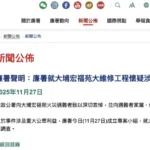Last night, the 2025 Beijing Xishan Yongding River Cultural Festival kicked off at Shougang Park, with the No. 3 Blast Furnace once again hosting the Blast Furnace Concert, offering audiences a spectacular cultural feast. From its debut in 2021 to the five-year commitment in 2025, the Blast Furnace Concert has evolved from a single performance into a “golden name card” of Beijing’s culture, also witnessing the development of the Xishan Yongding River Cultural Belt over the past five years.
At 7:30 PM, at the foot of Xishan Mountain and along the banks of the Yongding River, the No. 3 Blast Furnace in Shougang Park was adorned with dazzling light displays as a diverse and cross-disciplinary immersive concert began. The concert, themed “Eternal Mountains and Rivers, Peaceful Homeland,” was divided into two parts: “Red Memories” and “Colorful Future,” using melodies to connect the inheritance of national spirit with the pulse of contemporary development.
The creative team fully utilized the steel structure of the No. 3 Blast Furnace, transforming it into a “breathing stage.” Using lighting projection technology, they simulated the flames of war resistance with red光影 on the furnace walls, outlined the flowing轨迹 of the Yongding River with blue波纹, and created a sense of technological futurism with golden beams. The interior of the blast furnace was equipped with a surround sound system, creating an immersive audio experience that allowed the audience to feel the dialogue between history and the present through the integration of sound, light, and electricity.
Shougang Park, home to the Blast Furnace Concert, has undergone continuous transformation in recent years, riding the momentum of the Olympics. It has experienced three major shifts: from mountains to sea, from fire to ice, and from factory to park, becoming a new landmark of urban renewal in the capital for the “Together for a Shared Future” era. The No. 3 Blast Furnace has been revitalized and upgraded into a platform for premier launches and exhibitions; the No. 1 Blast Furnace has been transformed into the So-Real Sci-Fi Paradise, with the China Sci-Fi Conference held continuously, leading to the rise of a “sci-fi city” in western Beijing; the China International Fair for Trade in Services has established its permanent venue in Shougang Park, and the No. 4 Blast Furnace has been magnificently repurposed into the Shougang International Convention and Exhibition Center, becoming a new highlight in the sustainable reuse of industrial heritage.
To the west of Shougang Park, along the Yongding River, the Yongding River Collection integrates natural landscapes, industrial heritage, and fashionable commerce, creating a vibrant waterfront shoreline that blends water, beaches, banks, and the city. This autumn, it has provided citizens and tourists with a relaxing experience, and climbing Shijingshan Mountain has allowed more people to learn about the origin of Shijingshan District’s name. During the WTT event, new consumption scenes like the Yongding River Collection and train restaurants attracted nearly 40,000 visitors.
As a cultural gem on the Xishan Yongding River Cultural Belt, the Moshikou Historical and Cultural Block quickly became a popular打卡 spot in western Beijing after its opening on September 29, 2021. The Xishan Cuilin Tea House has been transformed into the Fahai Temple Mural Art Museum, the Laoye Temple has been updated into the Moshikou Historical and Cultural Folk Exhibition Hall “Ancient Path Preservation,” and more courtyards have been renovated, with boutique coffee shops, homestays, and餐饮 brands continuously moving in. The street has gathered 15 scenic spots, 30 courtyards, and over a hundred shops. In 2024, Moshikou received over 6 million visitors, and earlier this year, it was recognized as a national-level tourism and leisure block.
To showcase the development achievements of the Xishan Yongding River Cultural Belt over the past five years, from now until the end of October during the cultural festival, the Municipal Cultural Heritage Bureau will launch the “Mountain and River Heritage Journey” series of live broadcasts, visiting three cultural heritage sites along the belt: Yunju Temple, Fahai Temple, and Chengen Temple, focusing on cultural relic protection, digital displays, and cultural creativity.
Eight districts along the cultural belt will also simultaneously carry out various thematic activities. The Shijingshan Academy will open, building on the historical底蕴 of the Xishan Yongding River Cultural Belt with the宗旨 of “inheriting cultural heritage and nurturing the soul,” creating a cultural space that integrates典籍 collection, academic research, cultural exchange, and public reading, injecting “bookish energy” into the inheritance and innovation of the cultural belt.


